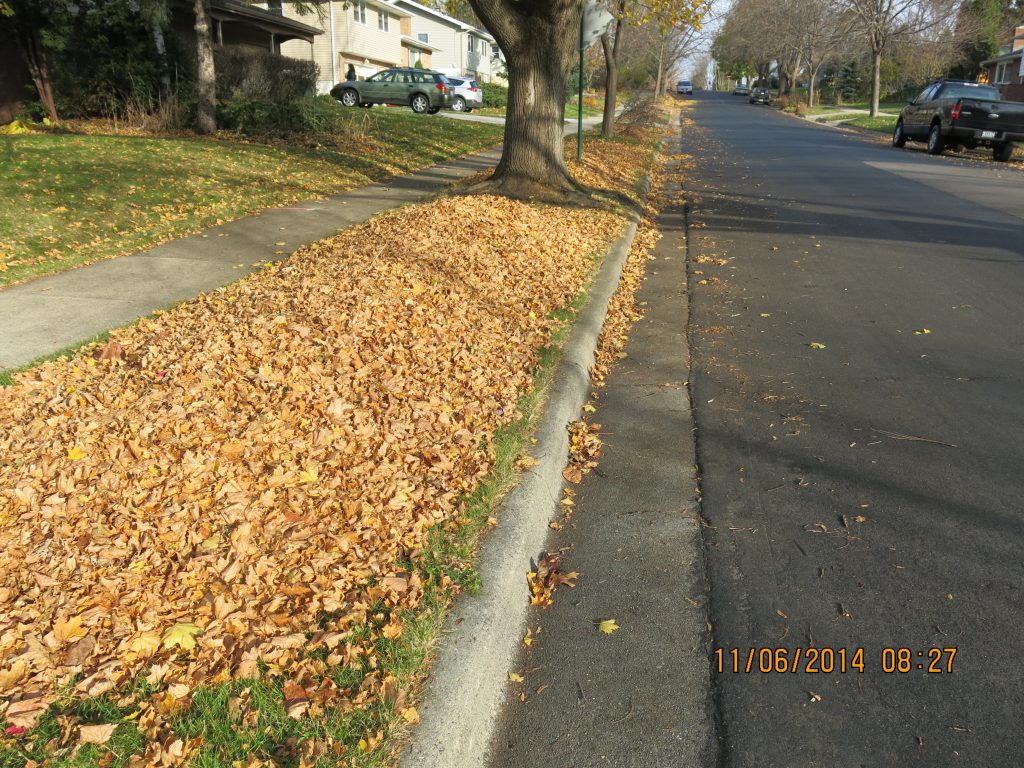By Roger Bannerman
Every Fall the leaves accumulating in our residential streets contribute to making Lake Wingra turn green in the summer. Rain water running through the fallen leaves can release nutrients, such as phosphorus and carry it to the lake. If the leaves are left on the street for the few weeks of the fall, the amount of phosphorus released can amount to about 50% of all the phosphorus reaching the lake in one year (Selbig, 2016). Like most cities, the City of Madison reduces the exposure of the leaves to rainfall by picking up the leaves 3 or 4 times during the fall. Picking up the leaves includes running street cleaners down each street. Madison’s leaf management program benefits all our lakes, but the benefit has not been quantified. The benefits of any leaf management program will depend on the accumulation rate of the leaves versus the frequency of rainfalls. Quantifying the reduction achieved with different leaf management programs is essential to understanding the role of any leaf management program in achieving the phosphorus reduction goals for Lake Wingra or any of our lakes.
| Frequency of Leaf Collection | % Phosphorus Reduced |
| No leaf accumulation | 80 |
| Once per week | 60 |
| 3-4 times per season | 40 |
Five years ago, the local United States Geological Survey (USGS) office assumed the responsibility of determining the amount of phosphorus reduction achieved with different leaf management programs. Funding sources for the project included the City of Madison, Wisconsin Department of Natural Resources, Madison Metropolitan Sewage District, Dane County, Lake Michigan Fund, and the USGS. Flow and water quality monitoring equipment was installed at the end of 5 storm sewer pipes in the City of Madison. The pipes drain a few acres of medium density residential area with mature trees overhanging the streets. Four different leaf management programs have been tested that mostly vary in the frequency of removing the leaves from the street. The extreme program was not allowing any leaves to accumulate, two programs removed leaves once per week, and the least frequent program picked up leaves 3 or 4 times a season. The results are very encouraging with the amount of reduction achieved with the three frequencies being 80, 60, and 40 percent, respectively. These results now give Madison and other cities the opportunity to compare leaf management programs to other phosphorus reduction efforts.
Short term and long term phosphorus reduction goals for Lake Wingra are presented in the Lake Wingra Watershed Management (City of Madison, 2015). A list of methods to control phosphorus, such as better leaf control, are compared in the plan. These recent results from the study will certainly help update a comparison of the control methods and achieve the goals. Although the study focused on the city’s leaf management program, the results also reveal the important role homeowners can have by keeping the leaves they rake out of the street and removing leaves that fall on the street.

Incorrect 
Correct
City of Madison; FOLW; and Strand Assoc., 2015 (https://www.cityofmadison.com/engineering/stormwater/documents/Section4-Phosphorus.pdf)
Selbig, William, 2016. Evaluation of leaf removal as a means to reduce nutrient concentrations and loads in urban stormwater. Science of the Total Environment 571 (2016) 124–133
Photos by Roger Bannerman

